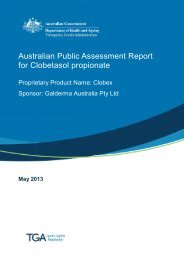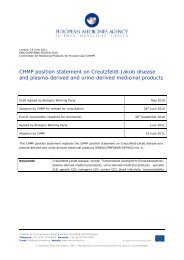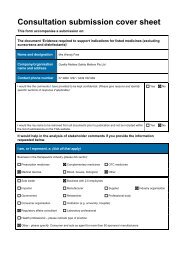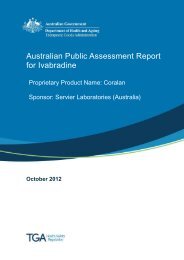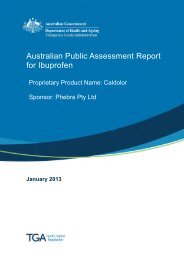AusPAR: Cabazitaxel - Therapeutic Goods Administration
AusPAR: Cabazitaxel - Therapeutic Goods Administration
AusPAR: Cabazitaxel - Therapeutic Goods Administration
Create successful ePaper yourself
Turn your PDF publications into a flip-book with our unique Google optimized e-Paper software.
Repeat dose toxicity<br />
<strong>AusPAR</strong> Jevtana <strong>Cabazitaxel</strong> Sanofi-Aventis Australia Pty Ltd PM-2010-02565-3-4<br />
Final 9 February 2012<br />
<strong>Therapeutic</strong> <strong>Goods</strong> <strong>Administration</strong><br />
All toxicity studies were conducted with administration by the IV route which is the<br />
proposed clinical route of administration. The duration of administration of the dose<br />
varied between a short infusion (generally about 1 min) to a longer infusion (generally<br />
about 1 h). Repeat dose toxicity studies were conducted in mice, rats and dogs.<br />
As noted above, these species are acceptable models. Studies were generally adequate in<br />
terms of duration, dosing frequency, animal numbers, the timing of investigations and<br />
other aspects of study design. The doses chosen, limited by toxicity, were generally<br />
acceptable, . Exposures at the highest adequately tested doses were >10 in mice and 2 in<br />
rats but were subclinical in dogs. Different dosing schedules were tested including daily<br />
administration (mice, rats and dogs), weekly administration (mice and dogs) and<br />
administration once every 3 weeks (mice, rats and dogs). The latter, as this is proposed<br />
clinical schedule, was chosen and cabazitaxel administered by 1 h infusion in these<br />
studies. Additionally, in rats, a study with daily administration for 4 weeks provided<br />
information for the selection of doses for the reproductive toxicity studies. The vehicle<br />
used in most of these studies was prepared from a stock solution of cabazitaxel in<br />
polysorbate 80 by dilution with 13% ethanol and then 5% glucose and was comparable to<br />
that proposed for registration. As expected, in all species, lethality, as well as other toxic<br />
effects, was influenced by dose, dosing frequency and dosing interval. Relative exposure of<br />
cabazitaxel in repeat dose toxicity studies is shown in Table 1.<br />
Table 1: Relative exposure of cabazitaxel in repeat dose toxicity studies<br />
Species<br />
(Strain)<br />
Mouse<br />
(CD-1)<br />
Rat<br />
(SD)<br />
Dog<br />
(Beagle)<br />
Human<br />
Duration/<br />
frequency<br />
5 cycles<br />
(1h infusion/<br />
3 weeks)<br />
5 days<br />
(1 min daily)<br />
10 cycles<br />
(1 h infusion/<br />
3 weeks)<br />
5 days<br />
(1h infusion<br />
daily)<br />
13 cycles<br />
(1h infusion/<br />
3 weeks)<br />
Dose<br />
(mg/kg<br />
/IV dose)<br />
AUC0–24h<br />
(ng·h/mL)<br />
AUC over<br />
3 weeks<br />
(ng·h/mL)<br />
5 5593 5593 6<br />
10 14146 14146 15<br />
15 13147 13147 14<br />
0.25 11.2b 56 0.06<br />
0.5 20.6 b 103 0.1<br />
1 76.9 b 385 0.4<br />
1 144 144 0.2<br />
5 942 942 1.0<br />
10 1910 1910 2<br />
20 9445 9445 10d 0.1 6.7 c 34 0.04<br />
0.1 9 9 0.01<br />
0.25 49 49 0.05<br />
0.5 157 157 0.2<br />
2 cycles<br />
(1h/3 weeks) [25 mg/m2] 953 953 –<br />
Exposure ratio<br />
based on AUC a<br />
a calculated as animal:human AUC over 3 weeks; data are for the sexes combined, and averages across<br />
sampling days;<br />
b AUC0−6h<br />
c AUC0−2h<br />
d only one dose achievable at this level due to severe toxicity, dose was lowered to 10 mg/kg<br />
Page 16 of 75





